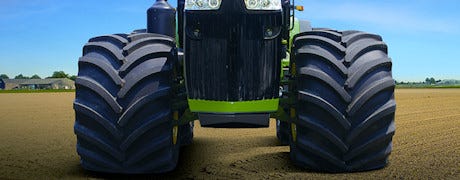April 5, 2016

Sponsored Content
Tractors are heavier and more powerful than ever before, and as a result, issues associated with soil compaction are becoming an increasingly common problem. Despite this, many growers continue to run tires that only worsen the problem — whether by choice or perceived lack of other options. But there are options out there, and growers need to fight for their right to float.
 Match tire selection to farm practices for best results.
Match tire selection to farm practices for best results.
“It’s all about the footprint. Think about it this way — if you walk out into the field on ice skates, you’re going to sink right into the mud. With boots, you’re good to go,” says Scott Sloan, agricultural product manager for Titan International and Goodyear Farm Tires. “I don’t see too many guys walking around the field in ice skates, but I do see a lot of guys running narrow duals when they don’t need to. If you’re not running the machine between the rows post-emergence, then there’s really no reason you shouldn’t be running Extreme Flotation tires.”
A recent study* revealed that only about 37 percent of American growers have a need to frequently run between the rows post-emergence. These 37 percent are the good candidates for running narrow duals on their tractors. However, an estimated 75 percent of MFWD setups still come from the factory with narrow duals. This means a large percentage of growers are running duals when it’s unnecessary.
COMPARE THE FOOTPRINT
Narrow duals
A common factory setup on MFWD tractors puts 480/80R50 duals on the rear and 420/85R34 duals on the front, resulting in the following:
Total contact area: 2,368 inches
15 psi rear / 9 psi front
Goodyear® Extreme Flotation™
An alternative to the factory dual setup is to run Goodyear LSW1100/45R46 single rears and LSW1000/40R32 single fronts, resulting in the following:
Total contact area: 2,716 inches (20 percent improvement)
8 psi rear / 6 psi front
Lower overall width for easier roading
Sharper turning radius
THE LSW® ADVANTAGE
In addition to spreading far less pressure over a much wider footprint (and thus, causing less soil compaction), the added stability of Low Sidewall (LSW) technology provides many other benefits to running Extreme Flotation tires. LSW technology features a larger wheel diameter and smaller sidewall than a conventional tire. This decreases the likelihood for sidewall recoil, which drastically improves ride quality and stability, and reduces power hop and road lope.
SWAP THE ICE SKATES FOR BOOTS
If you’re interested in getting set up with Extreme Flotation tires for your MFWD tractor, you can work with your equipment dealer in a couple different capacities:
Order your tractor barefoot (without the wheel and tire assembly). The OEM will then provide you with a credit for the assembly, which can be used on an Extreme Flotation setup.
Or
Talk to your dealer about exchanging your current conventional dual setup for an Extreme Flotation assembly. Many dealers offer to buy the standard wheel/tire assemblies from you and apply the credit toward a new set of Extreme Flotation tires.
Visit www.lswadvantage.com to learn more about LSW and Extreme Flotation technology, and see what real farmers have to say about making the switch.
*November 2015 survey conducted via AgWeb, involving 273 grower respondents.
About the Author(s)
You May Also Like




